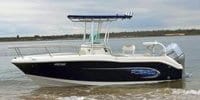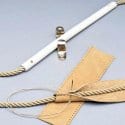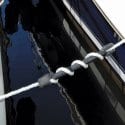 By Bob Currie, Vessel Examiner
By Bob Currie, Vessel Examiner
United States Coast Guard Auxiliary Station Galveston Flotilla.
The One That Almost Got Away
I received word that there was an unoccupied boat similar to the one in the picture floating loose in Stingaree Marina. By the time I got to the marina someone had rescued the boat and tied it up in a wet stall. I was able to trace the owner using the TX number on the side of the boat and notify him that his boat had broken loose from its moorings, that it had been rescued, and where it could be found. Upon investigation, I noticed that the boat’s mooring lines had been worn in two.  This happens when the mooring lines are not protected from chafing by chafing gear. As the boat rises and falls with the tide, the mooring lines rub against the dock and eventually wear to the point that they break, allowing the boat to float out of its stall. Luckily for the owner in this case the boat had not floated out into the Intracoastal Waterway, where it could have been struck by barge or other vessel traffic. The key to properly mooring your boat in a wet stall is to install chafing gear to help prevent your mooring lines from wearing in two, and use snubbers to absorb the shock of the motion of the boat due to waves and tides.
This happens when the mooring lines are not protected from chafing by chafing gear. As the boat rises and falls with the tide, the mooring lines rub against the dock and eventually wear to the point that they break, allowing the boat to float out of its stall. Luckily for the owner in this case the boat had not floated out into the Intracoastal Waterway, where it could have been struck by barge or other vessel traffic. The key to properly mooring your boat in a wet stall is to install chafing gear to help prevent your mooring lines from wearing in two, and use snubbers to absorb the shock of the motion of the boat due to waves and tides.
The Station Galveston Flotilla of the US Coast Guard Auxiliary operates out of the USCG Station Galveston base on Galveston Island. They provide assistance to the Coast Guard by providing maritime observation patrols in Galveston Bay; by providing recreational boating vessel safety checks; and by working alongside Coast Guard members in maritime accident investigation, small boat training, watch standing, and property administration.
Care of Lines

Line, no matter what it is made of, needs special care. Even the strongest synthetic line, if subject to abuse, can deteriorate to the point of failure. This is often the case with mooring lines. Where lines are subject to abrasion, they should be protected with chafing gear, such as canvas, leather, or rubber hose wrapped around the line at the point of abrasion. The chafing gear should be checked periodically, as it, too, can be worn due to abrasion. Abrasion happens when waves rock the boat, or when the boat rises and falls within the wet stall due to the action of the tides. Some other methods of care will help ensure your boat doesn’t end up floating out into the shipping channel:
- Keep your lines clean. Dirt acts like sandpaper on all types of line.
- Match your line size and type to its use. Use mooring line for mooring your boat.
- Keep chemicals such as gasoline and solvents away from your line.
- Avoid excessive wear. Reverse your lines end to end to even out the wear.
- Avoid kinks in your line. Kinks are the weakest part of any line.
- Do not run your lines over sharp angles, and use chafing gear where there is contact with the dock.
- Use a snubbers such as bungee cords to absorb any shocks, using the mooring line as a failsafe. Note that the snubbed line in the picture could also use some chafing gear at the point where it touches the gunnel of the boat.

Summary
If you wan your boat to be there when you get to your boat’s wet stall, then make sure that you protect your mooring lines from abrasion by using chafing gear and snubbers.
For more information on boating safety, please visit the Official Website of the U.S. Coast Guard’s Boating Safety Division at www.uscgboating.org. Questions about the US Coast Guard Auxiliary or our free Vessel Safety Check program may be directed to me at [email protected]. I am available to perform free Vessel Safety Checks, and I will come to your location to perform them. SAFE BOATING!
[12-31-2018]

 Posted in
Posted in 























